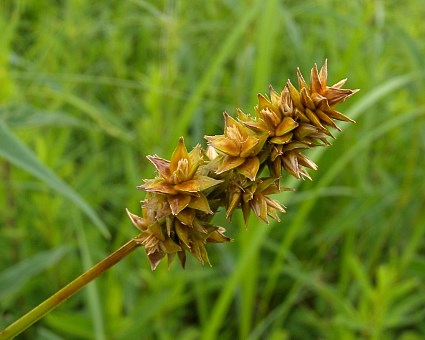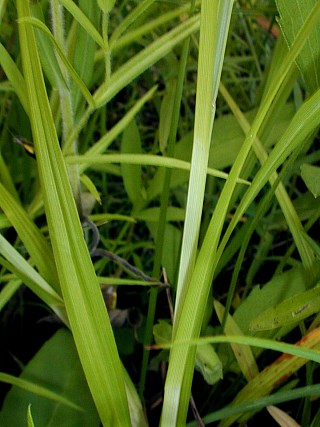Description: This perennial sedge is about 1½–3' tall. The fertile culm is light green, 3-angled, hairless, and slightly rough along the edges underneath the inflorescence. About 3-5 alternate leaves can be found along the lower one-third of the culm. The blades of these leaves are up to 10" long and 8 mm. across; they are light to medium green, hairless, and ascending to widely spreading. The hairless sheaths of the leaves are light green along the outer two surfaces, and white-translucent along the inner surface. Each culm terminates in a compact inflorescence about 1-2" long and ¾" across. Each inflorescence consists of 5-15 short chunky spikelets. Each spikelet has 5-15 ascending to widely spreading perigynia and pistillate scales; staminate (male) florets are located above the pistillate (female) florets. At the base of the lowest spikelet, there may be a linear bract up to 1" in length, while other spikelets have much shorter or no bracts.

The flattened
perigynia are ovoid to nearly globoid, tapering to short beaks. They
are plano-convex (flat on one side, slightly convex on the other side)
and wingless along their margins. The outer (convex) side of each
perigynium usually has a few faint vertical nerves toward its bottom,
while the inner (flat) side is nerveless. Each perigynium is
approximately 4 mm. long and 2.5 mm. across; there is significant
variability across populations in the relative length in relation to
its width (from 0.5–0.75 as wide as long). The pistillate scales are
ovate and about the same length as the perigynia. The short-lived
blooming period occurs during late spring. During the maturation
process, the perigynia and their scales change from green, to reddish
yellow-brown, to dark brown. Each perigynium contains a single achene
that this globoid-quadrangular and flattened, spanning about 2 mm. long
and 2 mm. across. The perigynia and their achenes are blown about by
the wind; they are also transported from the mother plant when the
fertile culm topples over. Because the root system is short-rhizomatous
and fibrous, this sedge often forms a tuft of leafy culms.
Cultivation:
The preference is full to partial sun and mesic conditions. This
competitive sedge adapts readily to loamy, sandy, or rocky soil, as
long as it is not too acid.

Range & Habitat:
The native Heavy Sedge is fairly common in northern and central
Illinois, but only
occasional in southern Illinois (see Distribution
Map). Habitats include black soil prairies, sand prairies,
gravel prairies, disturbed meadows, savannas and open woodlands,
roadside embankments, abandoned fields, and shallow ditches (if not too
wet). In Illinois, this is primarily a prairie sedge, although it is
occasionally found in more disturbed habitats.
Faunal Associations:
Sedges that occur in prairies and other upland areas are sources of
food to many insects, upland gamebirds, and songbirds. Grasshoppers are
particularly well-represented in prairies (especially gravel and sand
prairies), and a large number of species occasionally feed on the
foliage of sedges (see the Grasshopper Table for a list
of these species). However, most grasshoppers are polyphagous and the
listed species are not solely dependent on sedges as a food source.
Other insects that feed on sedges include aphids, leafhoppers, weevils
(whose larvae often live within the culms), seed bugs (Lygaeidae),
skipper caterpillars (Hesperiidae), and moth caterpillars. Many of
these insects are important sources of food to insectivorous birds. The
Prairie Chicken, Wild Turkey, Ring-Necked Pheasant, native sparrows,
and winter songbirds eat the seeds or seedheads of upland sedges in sunny areas (see
the Bird
Table for a list of these species). However, sedges are only
a minor source of food to herbivorous mammals, such as the Prairie Vole
and White-Tailed Deer.
Photographic Location:
The Loda Cemetery Prairie in the southwest corner of Iroquois County,
Illinois. This is a mesic black soil prairie.
Comments:
Because of its resemblance to several other sedges (Carex spp.) and the
variability of its local populations, this sedge can be difficult to
identify. As a general rule, the seedheads of this sedge are more
compact and chunky than the seedheads of other similar sedges, and its
perigynia are larger than average in size. The perigynia also have
fewer conspicuous veins along their sides and they lack the narrowly
winged margins that are typical of the perigynia of other similar
sedges. The leaf blades of Heavy Sedge are often more broad (up to 8
mm.) than those of other prairies sedges, which enables this species to
tolerate the shade of other plants in the tallgrass prairie as the
growing season progresses.